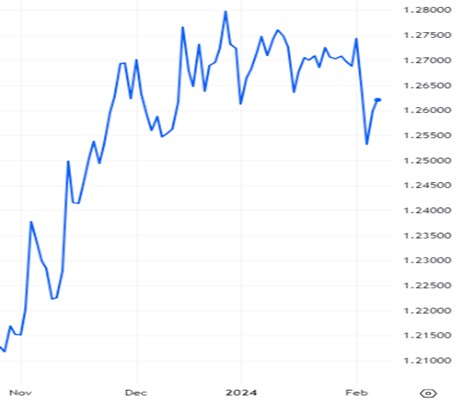GBP-USD Exchange Rate Posts Slight Loss During Turbulent January
Having treaded water into the new year, the GBP-USD exchange rate plunged lower on 2 January. The pound’s increasingly risk-sensitive nature caused it to weaken sharply against the safe-haven dollar, leaving it a fraction above the 1.26 benchmark.
The UK currency managed to pare some of its losses two days later following a better-than-expected final service sector PMI. Activity was stronger in December than forecast, causing optimism amongst firms to reach a seven-month high – and the pound to climb back above 1.27.
Stronger-than-forecast US jobs data dented the pound’s recovery. December’s non-farm payrolls report showed that the US economy added 216,000 jobs, up from 173,000 in November and above forecasts of 170,000. Meanwhile, the unemployment rate unexpectedly held steady at 3.7% and hourly earnings ticked up. The favourable conditions pointed to resilience in the US labour market, prompting investors to scale back bets on a March interest rate cut from the Fed.
Risk-off support for the dollar quickly faded, causing the GBP-USD exchange rate to jump sharply into the 1.27 mid-range.
Having remained rangebound, the pound began trending lower against the dollar on 8 January amid a lull in data, before waning interest rate cut expectations gave it a shot in the arm.
The UK currency briefly dipped below the 1.27 benchmark on 10 January after the dollar was supported by trade balance figures and comments from FOMC Member Barr, who hinted at a cautious and measured approach by the Fed.
A choppy spell included robust UK GDP data that showed the economy rebounded more than expected in November driven by growth in the services sector, easing fears of a technical recession.
The pound slumped on 17 January after risk-off flows were compounded by rising retail sales in the US that signalled economic strength, dimming expectations for imminent Fed rate cuts.
The GBP-USD exchange rates fall was cushioned by CPI data that showed UK inflation rose in December – denting BoE rate cut bets. Headline inflation printed at 4%, up from November’s 3.9% reading, and ahead of forecasts it would dip to 3.8% – an unexpected rise that marked the first increase in 10 months.
Having rebounded above 1.27, the pound was hit by an unexpected dip in UK retail sales on 19 January. The figures reported that sales slumped by a whopping 3.2% in December, outstripping the modest 0.5% drop forecast – a surprising contraction that stoked concerns the UK fell into a technical recession in the fourth quarter of 2023.
The GBP-USD pair traded sideways following reports that UK borrowing costs fell by half at the end of last year, before surging on better-than-expected UK PMIs. Notably for the powerhouse services sector, which posted its highest level of growth in eight months.
The pound’s sharp rise was capped by a lack of subsequent data from the UK economy, leaving it unable to capitalise on raised bets on an imminent rate cut from the Fed amid cooling US inflation.
Widespread risk aversion prevented the GBP-USD exchange rate from clinging onto its gains, dragging it back below 1.27 on 30 January as the safe-haven dollar strengthened – a sudden fluctuation that reflected a turbulent month for the pair.
GBPUSD: 3-Month Chart

Looking ahead
The BoE is expected to take a first step towards cutting interest rates from their highest level in nearly 16 years on 1 February following signs that the inflation crisis is abating.
Influential data from the UK economy in February: ILO Unemployment Rate (13 February), Consumer Price Index (14 February), Gross Domestic Product (15 February), Retail Sales (16 February), S&P Global/CIPS Services PMI (22 February).
Influential data from the US economy in February: ISM Manufacturing PMI (1 February), Nonfarm Payrolls (2 February), ISM Services PMI (5 February), Consumer Price Index (13 February), Retail Sales (15 February), Producer Price Index excluding Food & Energy (16 February), S&P Global Services PMI (21 February), Gross Domestic Product Annualised (28 February), Core Personal Consumption Expenditures Price Index (29 February).






